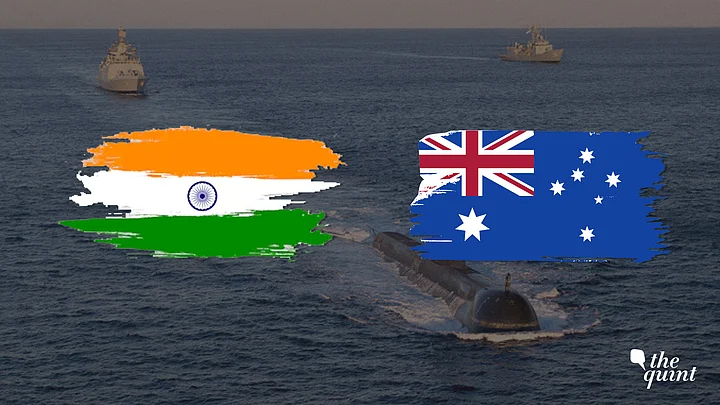With the third – and largest – AUSINDEX naval exercises between India and Australia kicking off on Tuesday, 2 April, it’s a good time to look at the relationship between the two countries.
The exercise, being held off the coast of Visakhapatnam till 16 April, constitutes the “largest ever deployment of an Australian defence group” to India.
In this context, The Quint spoke to three experts in the field – veteran diplomat Vishnu Prakash, Rory Medcalf, Head of National Security College at Australian National University and Dr David Brewster, senior research fellow at the National Security College, ANU – to see where the relationship is going, the message these exercises can be expected to send to China, and the significance of the Quad grouping.
India-Australia Relationship: Where Does it Stand?
Underlining the significance of this year’s AUSINDEX exercise, Dr David Brewster calls it the “largest and most sophisticated yet.”
“…the inclusion of Australian and Indian submarines in this iteration of AUSINDEX is probably the most significant change. It signals that each side is willing to expose what is probably their most sensitive assets to each other to beef up cooperation in Anti-Submarine Warfare. Exercising with submarines is really the top end of cooperation.”David Brewster to The Quint
On being asked whether the Indo-Aus ties show any signs of stagnation, both Rory Medcalf and Vishnu Prakash disagree. Medcalf said, "The exercise confirms growing levels of cooperation between Australia and India at sea... It is ill-informed nonsense to suggest the relationship is stagnating... India is quietly recognising Australia's significant role in the Indo-Pacific."
However, Brewster adds that it is in the economic domain that the two countries need to work further. “A hoped-for FTA (free trade agreement) did not proceed due to Indian concerns about maintaining tariff restrictions. Instead the two countries need to find different approaches to pursue economic integration,” he remarks.
The Message for China
This largest AUSINDEX exercise, focusing on anti-submarine warfare, would most certainly be keenly watched by China.
On the implication of the exercise for China, Medcalf says,
“This exercise is a reminder that Australia and India are quietly improving their ability to work together on defence and maritime security, including to remind China that other countries together can balance the possible future misuse of its power.”Rory Medcalf to The Quint
In a similar vein, Prakash points out China would have been happier if exercises such as the AUSINDEX did not take place. But considering India's growing status in the region and the "adverserial relationship" it shares with China, it is imperative for it to look after its own national security, he points out.
The Quad and the Malabar Exercises
Two significant aspects of the India-Australia relationship have been the Quadrilateral Security Dialogue (popularly called the Quad) – which include Australia, India, Japan and the US – and the Malabar naval exercises, which India has been reluctant to include Australia in.
The Quad, Prakash says, has a “chequered history”. Initiated in 2007 to uphold strategic interests in the Indo-Pacific region and as a response to growing Chinese clout, the grouping suffered an early setback with the withdrawal of Australia in 2008. However, in 2017, on the sidelines of the ASEAN summit in Manila, the Quad was brought back into existence.
Meanwhile, the Malabar naval exercises, which began in 1992 as a bilateral exercise between India and US, have been expanded to occur annually and also took in Japan as a permanent member in 2015. Barring 2007 – when Australia was invited to participate as an observer – it has been conspicuous by its absence in the exercise.
Even after the revival of the 'Quad', Australia was left out of the trilateral Malabar exercise in 2018, with India not accepting its request despite the former’s ‘willingness’ to take part.
One reading of this move was that the inclusion of Australia in the Malabar exercises might give the Quad a "direct associated military angle, which could provoke and severely increase Chinese security concerns in the Indo-Pacific." And this would have stood "contrary to the spirit of improving bilateral India-China relations" at the time.
In the current scenario, Vishnu Prakash labels the Quad as a “a platform for consultation where one can exchange ideas, with a broad similarity of outlook."
Meanwhile, Brewster refutes the contention that India lacks enthusiasm for the Quad as a security dialogue.
“But consistent with its history, India is extremely cautious about becoming involved in multilateral security cooperation. So if some pundits (incorrectly) want to see the Quad become a conduit for multilateral security cooperation, they will probably be disappointed.”David Brewster to The Quint
He does agree that India has become very cautious about doing anything that might upset China, especially since the Wuhan Summit.
And as far as the Malabar is concerned, Medcalf points out that while Australia's inclusion in the exercise would be desirable, it is "not essential".
“A substantial bilateral exercise is proof of a growing security partnership between two highly capable powers... And in time, by demonstrating through bilateral activities that Australia is a serious security partner, then the door will and should open to Malabar.”Rory Medcalf to The Quint
The Way Forward
According to Brewster, though defence cooperation between India and Australia, including in the naval and intelligence dimensions is growing significantly, a few "institutional limitations primarily on the India side" have limited growth in cooperation.
Nevertheless, he says the opportunities for cooperation exist, especially from using shared platforms that have not yet been pursued.
“Ideally, one day Australia would like to see joint exercises involving, say, the navies and air forces of the two countries. But that would be a difficult step for India.”David Brewster to The Quint
